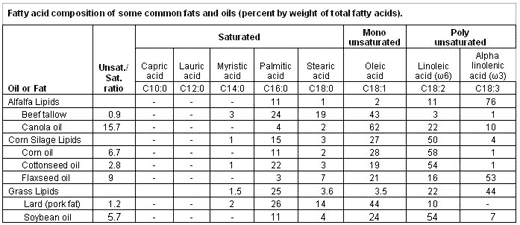Feeding Fat: The Good, the Bad and the Ugly
Published: March 31, 2008
Source : University of Minnesota Dairy Extension
Fats consumed by dairy animals are in the form of triglycerides, composed of a glycerol backbone with three attached fatty acids. Once in the rumen, the fatty acids separate and become free. If fatty acids are saturated, they can flow to the small intestine to be absorbed. If they are unsaturated, fatty acids must be biohydrogenated (add hydrogen) by rumen bacteria so not to be toxic to the bacteria. The make-up of the fatty acids has a great impact on the fat, its effect in the rumen and the value to the animal. Table 1 is a comparison of the fatty acids in common feed ingredients as well as butterfat.
Feeding fat has advantages and disadvantages for the dairy animal. I have divided these into the good, the bad and the ugly.
The Good
Feeding fat increases the energy density of the ration. As cows milk more, they need more energy and there is a limit on how much starch can be fed. Fat also contains approximately 2.25 times as much energy as starch. Feeding fat can alleviate some of the shortcoming of poor forage and its limitations on feed intake as well.
In recent years, there has been tremendous interest in the value of feeding particular fatty acids for reproduction. Certain omega-3 fatty acids are required by the animal for the production of specific hormones. Including these in diets has shown to improve the pregnancy rate in cows by reducing the production of certain prostaglandins. They may also improve the omega-3 : omega-6 ratio which may help cows in the transition period.
The Bad
Forage quality, the amount of forage fed, and feeding grains are main factors in keeping feed costs down because they are less expensive than fat sources. Additionally, fats in commodity by-products are calculated on the basis of partial contribution and, thus, supplementing tallow or rumen inert fats are higher priced ingredients.
Feeding over 5% of the diet as fat can have negative effects on dry matter intake and milk production. There is a point where additional fat fed does not result in increased intake or milk production and this point is variable with different feed ingredients.
The Ugly
Since unsaturated fatty acids are toxic to rumen bacteria, they can react with the lipid membrane of bacteria cells, causing them to be disrupted and lead to death of the cell. If biohydrogenation does not keep up with hydrolysis of the triglycerides, the resulting death of bacteria mainly believed to be fiber digesters, there will be a decrease in digestion of fiber. Rumen conditions that result in incomplete biohydrogenation include acidosis or sub-acute acidosis conditions due to not enough effective fiber, addition of monesin, fat or too much starch.
Conclusion
The addition of fat to diets of dairy animals can be beneficial to improve the energy balance in lactating cows. This should improve milk production and reproduction. However, feeding fat must be carefully monitored for negative effects on feed intake, milk production and milk components.

Percentages may not add to 100% due to rounding and other constituents not listed. Where percentages vary, average values are used.
Source
University of Minnesota Dairy ExtensionRelated topics
Join to be able to comment.
Once you join Engormix, you will be able to participate in all content and forums.
* Required information
Would you like to discuss another topic? Create a new post to engage with experts in the community.
Create a post




.jpg&w=3840&q=75)